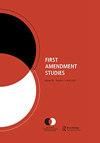Protesting with guns and conflating the First and Second Amendments: The case of the Bundys
Q2 Social Sciences
引用次数: 2
Abstract
ABSTRACT This article analyzes the legal discourse surrounding two armed anti-government confrontations – at Bunkerville, Nevada, in 2014, and the Malheur National Wildlife Refuge in Oregon in 2016 – to understand how the public makes sense of the relationship between First and Second Amendment rights. Using the concept of non-judicial precedents and drawing on legal scholarship following District of Columbia v. Heller (2008), we find that public meaning-making mirrors concerns raised by legal scholars about using First Amendment logics to understand Second Amendment rights, conflating the two in meaning and practice. Discourse surrounding these armed confrontations focused on whether guns were needed to protect speech rights, the rhetoric of patriotism, and the contested constitutional primacy of speech versus guns. We argue that this case study demonstrates the need for communication scholars to problematize the logics that intertwine the First and Second Amendments, especially as the nation confronts the normalization of the use of guns in political protest, conflict, and insurrection.持枪抗议,并将第一和第二修正案混为一谈:邦迪一家的案例
摘要本文分析了2014年在内华达州邦克维尔和2016年在俄勒冈州马尔赫尔国家野生动物保护区发生的两起武装反政府对抗的法律话语,以了解公众如何理解第一修正案和第二修正案权利之间的关系。利用非司法判例的概念,并借鉴哥伦比亚特区诉海勒案(2008)之后的法律学术,我们发现公共意义的形成反映了法律学者对使用第一修正案逻辑来理解第二修正案权利的担忧,在意义和实践上将两者混为一谈。围绕这些武装对抗的讨论集中在是否需要枪支来保护言论权、爱国主义的言论,以及言论与枪支之间有争议的宪法首要地位。我们认为,这一案例研究表明,传播学者有必要对第一修正案和第二修正案之间的逻辑提出质疑,尤其是在国家面临政治抗议、冲突和暴动中使用枪支的正常化之际。
本文章由计算机程序翻译,如有差异,请以英文原文为准。
求助全文
约1分钟内获得全文
求助全文
来源期刊

First Amendment Studies
Social Sciences-Law
自引率
0.00%
发文量
0
期刊介绍:
First Amendment Studies publishes original scholarship on all aspects of free speech and embraces the full range of critical, historical, empirical, and descriptive methodologies. First Amendment Studies welcomes scholarship addressing areas including but not limited to: • doctrinal analysis of international and national free speech law and legislation • rhetorical analysis of cases and judicial rhetoric • theoretical and cultural issues related to free speech • the role of free speech in a wide variety of contexts (e.g., organizations, popular culture, traditional and new media).
 求助内容:
求助内容: 应助结果提醒方式:
应助结果提醒方式:


